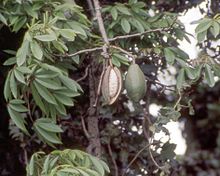Chorisia
| Ceiba | |
|---|---|
 |
|
| Ceiba pentandra leaves and fruit | |
| Scientific classification | |
| Kingdom: | Plantae |
| (unranked): | Angiosperms |
| (unranked): | Eudicots |
| (unranked): | Rosids |
| Order: | Malvales |
| Family: | Malvaceae |
| Subfamily: | Bombacoideae |
| Genus: |
Ceiba Mill. |
| Species | |
|
About 10–20 species, including: |
|
About 10–20 species, including:
Ceiba aesculifolia
Ceiba chodatii
Ceiba glaziovii
Ceiba insignis
Ceiba pentandra
Ceiba rosea
Ceiba speciosa
Ceiba trichistandra
Ceiba is the name of a genus of many species of large trees found in tropical areas, including Mexico, Central America, South America, the Caribbean, West Africa, and Southeast Asia. Some species can grow to 70 m (230 ft) tall or more, with a straight, largely branchless trunk that culminates in a huge, spreading canopy, and buttress roots that can be taller than a grown person. The best-known, and most widely cultivated, species is Kapok, Ceiba pentandra, one of several trees called kapok.
Recent botanical opinion incorporates Chorisia within Ceiba, raising the number of species from 10 to 20 or more, and puts the genus as a whole within the family Malvaceae. Ceiba species are used as food plants by the larvae of some Lepidoptera (butterfly and moth) species, including the leaf-miner Bucculatrix ceibae, which feeds exclusively on the genus.
The tree figures an important part in the mythologies of pre-Columbian Mesoamerican cultures. For example, several Amazonian tribes of eastern Peru believe deities live in Ceiba tree species throughout the jungle. The Maya civilization believed, Yaaxché, a concept of the central world tree is often depicted as a Ceiba trunk, which connects the planes of the Underworld (Xibalba), the terrestrial realm and the skies. The unmistakable thick conical thorns in clusters on the trunk were reproduced by the southern lowland Maya of the Classical Period on cylindrical ceramic burial urns or incense holders.
...
Wikipedia
